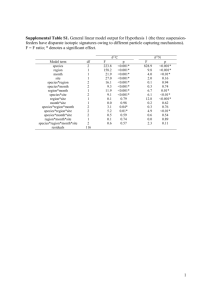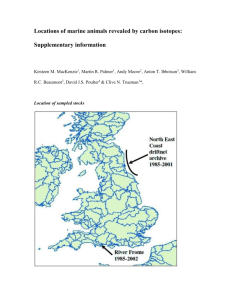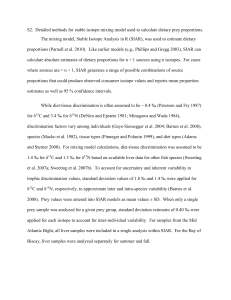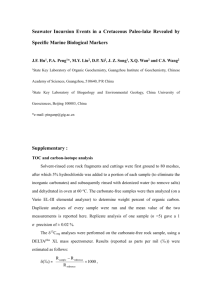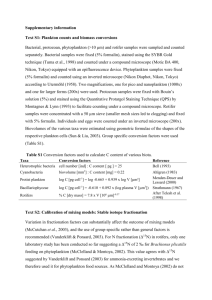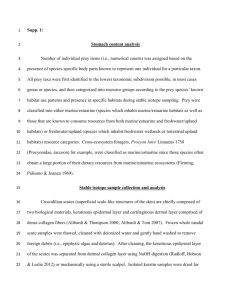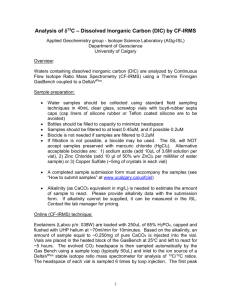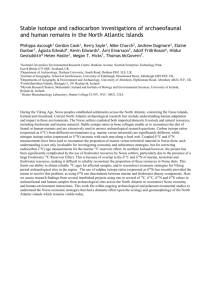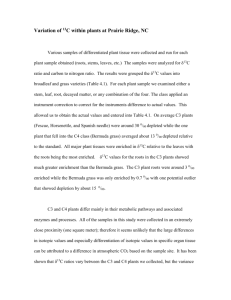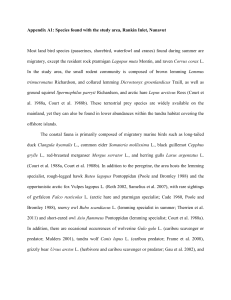Lipid corrections in carbon and nitrogen stable isotope analyses
advertisement
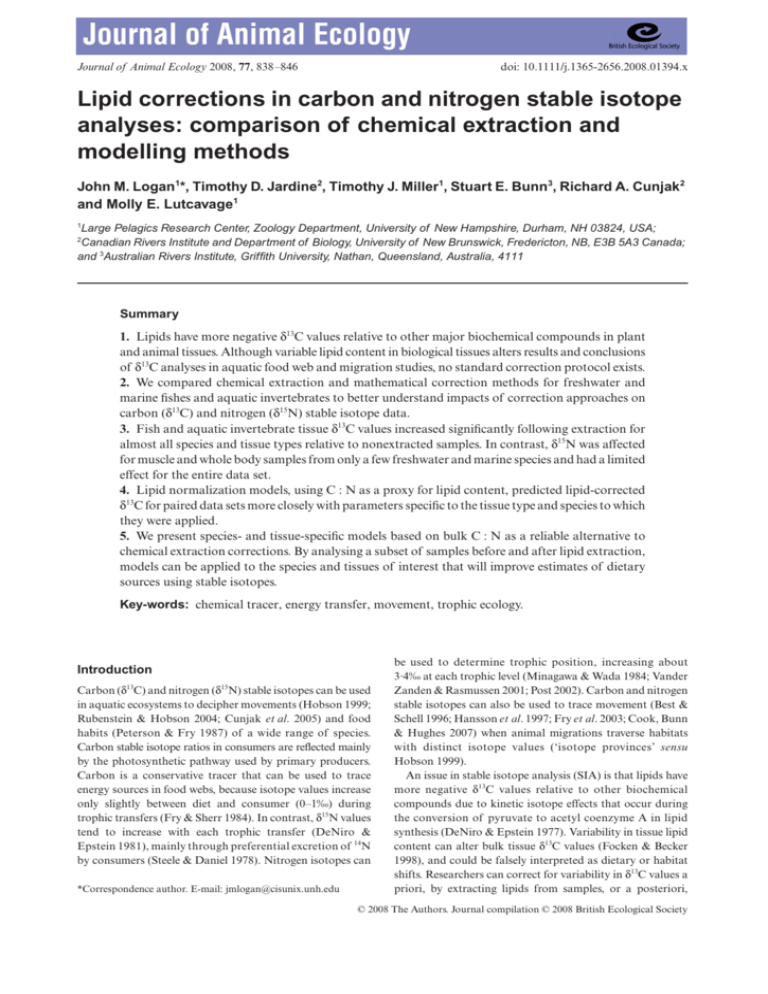
Journal of Animal Ecology 2008, 77, 838–846 doi: 10.1111/j.1365-2656.2008.01394.x Lipid corrections in carbon and nitrogen stable isotope analyses: comparison of chemical extraction and modelling methods Blackwell Publishing Ltd John M. Logan1*, Timothy D. Jardine2, Timothy J. Miller1, Stuart E. Bunn3, Richard A. Cunjak2 and Molly E. Lutcavage1 1 Large Pelagics Research Center, Zoology Department, University of New Hampshire, Durham, NH 03824, USA; Canadian Rivers Institute and Department of Biology, University of New Brunswick, Fredericton, NB, E3B 5A3 Canada; and 3Australian Rivers Institute, Griffith University, Nathan, Queensland, Australia, 4111 2 Summary 1. Lipids have more negative δ13C values relative to other major biochemical compounds in plant and animal tissues. Although variable lipid content in biological tissues alters results and conclusions of δ13C analyses in aquatic food web and migration studies, no standard correction protocol exists. 2. We compared chemical extraction and mathematical correction methods for freshwater and marine fishes and aquatic invertebrates to better understand impacts of correction approaches on carbon (δ13C) and nitrogen (δ15N) stable isotope data. 3. Fish and aquatic invertebrate tissue δ13C values increased significantly following extraction for almost all species and tissue types relative to nonextracted samples. In contrast, δ15N was affected for muscle and whole body samples from only a few freshwater and marine species and had a limited effect for the entire data set. 4. Lipid normalization models, using C : N as a proxy for lipid content, predicted lipid-corrected δ13C for paired data sets more closely with parameters specific to the tissue type and species to which they were applied. 5. We present species- and tissue-specific models based on bulk C : N as a reliable alternative to chemical extraction corrections. By analysing a subset of samples before and after lipid extraction, models can be applied to the species and tissues of interest that will improve estimates of dietary sources using stable isotopes. Key-words: chemical tracer, energy transfer, movement, trophic ecology. Introduction Carbon (δ13C) and nitrogen (δ15N) stable isotopes can be used in aquatic ecosystems to decipher movements (Hobson 1999; Rubenstein & Hobson 2004; Cunjak et al. 2005) and food habits (Peterson & Fry 1987) of a wide range of species. Carbon stable isotope ratios in consumers are reflected mainly by the photosynthetic pathway used by primary producers. Carbon is a conservative tracer that can be used to trace energy sources in food webs, because isotope values increase only slightly between diet and consumer (0–1‰) during trophic transfers (Fry & Sherr 1984). In contrast, δ15N values tend to increase with each trophic transfer (DeNiro & Epstein 1981), mainly through preferential excretion of 14N by consumers (Steele & Daniel 1978). Nitrogen isotopes can *Correspondence author. E-mail: jmlogan@cisunix.unh.edu be used to determine trophic position, increasing about 3·4‰ at each trophic level (Minagawa & Wada 1984; Vander Zanden & Rasmussen 2001; Post 2002). Carbon and nitrogen stable isotopes can also be used to trace movement (Best & Schell 1996; Hansson et al. 1997; Fry et al. 2003; Cook, Bunn & Hughes 2007) when animal migrations traverse habitats with distinct isotope values (‘isotope provinces’ sensu Hobson 1999). An issue in stable isotope analysis (SIA) is that lipids have more negative δ13C values relative to other biochemical compounds due to kinetic isotope effects that occur during the conversion of pyruvate to acetyl coenzyme A in lipid synthesis (DeNiro & Epstein 1977). Variability in tissue lipid content can alter bulk tissue δ13C values (Focken & Becker 1998), and could be falsely interpreted as dietary or habitat shifts. Researchers can correct for variability in δ13C values a priori, by extracting lipids from samples, or a posteriori, © 2008 The Authors. Journal compilation © 2008 British Ecological Society Lipid corrections in stable isotope analyses 839 through mathematical corrections. Lipid extractions were performed prior to δ13C analysis in only 10% of published studies that we reviewed mainly because they used lowlipid tissues such as bird feathers and fish muscle; even fewer have applied lipid correction or normalization techniques (Kline 1999; Matthews & Mazumder 2005). In stable isotope studies of food webs, reducing interindividual δ13C variation in improving dietary source proportion estimates is a desirable objective (Post et al. 2007). Several different normalization, correction and chemical extraction methods have been applied in stable isotope studies of food webs (Kelly 2000), but a standard protocol for lipid correction does not exist. Most corrections use elemental carbon to nitrogen ratios (C : N) of bulk tissue as a proxy for lipid content in estimating δ13C of lipid-free tissue (McConnaughey & McRoy 1979; Fry 2002; Kiljunen et al. 2006; Sweeting, Polunin & Jennings 2006; Post et al. 2007). As lipids are composed mainly of carbon and most lipid classes contain no nitrogen, increases in C : N ratios closely track increases in lipid content (Schmidt et al. 2003; Bodin, Le Loc’h & Hily 2007; Post et al. 2007). In addition, correct values for protein–lipid δ13C discrimination and C : N of lipid-free tissue are uncertain, and approaches for a given taxa (e.g. zooplankton, Smyntek et al . 2007) may not be appropriate for other unrelated taxa or tissues (Kiljunen et al. 2006; Post et al. 2007). Lipids are a major component of energy flow in food webs, and valuable ecological information is lost when they are extracted (Arts, Ackman & Holub 2001). When lipid extractions are performed for δ13C correction prior to SIA, most researchers analyse the single lipid extracted sample for both δ13C and δ15N. Common extraction methods alter δ15N to varying degrees in fish tissue (Sotiropoulos, Tonn & Wassenaar 2004; Murry et al. 2006; Sweeting et al. 2006), indicating that duplicate samples (one extracted, one nonextracted) are needed for optimal estimation of δ13C and δ15N. We conducted an analysis of δ13C and δ15N for a broad range of freshwater and marine fishes and invertebrates, without treatment and following chloroform–methanol lipid extraction in order to explore extraction effects on SIA results. Models using tissue C : N and bulk δ13C were tested as an alternative approach to correct for lipid δ13C alteration in fish and invertebrate tissues. Our objective was to provide practical solutions for researchers using SIA who are dealing with the potential confounding influence of lipids in aquatic food web and migration studies. Methods SAMPLE COLLECTION AND PROCESSING Samples of 431 marine and freshwater fishes and invertebrates representing 18 families were analysed for δ13C and δ15N with and without chloroform–methanol lipid extraction treatment (Table 1). All samples were stored frozen for a maximum of seven months before analysis. Freezing has not altered δ13C or δ15N values for fish (Sweeting, Polunin & Jennings 2004) or marine invertebrate tissues (Bosley & Wainright 1999), but has affected freshwater zooplankton (Feuchtmayr & Grey 2003). Our comparisons of δ13C and δ15N between lipid extracted and bulk tissue samples were based on aliquots of dried, homogenized samples subjected to identical frozen storage conditions. Liver, muscle and gonad samples were removed from selected fish species (Table 1), thawed, lightly rinsed with deionized water, transferred to glass scintillation vials and dried at 60 °C for at least 48 h. The remaining fishes and all invertebrates were dried whole, with pooled samples of two to 20 individuals used for freshwater invertebrates and whole individuals used for marine invertebrates. Larger whole Atlantic herring Clupea harengus (Linnaeus), Atlantic mackerel Scomber scombrus (Linnaeus), silver hake Merluccius bilinearis (Mitchill) and shortfin squid Illex illecebrosus (Leseur) were lightly rinsed with deionized water, then finely minced and dried in aluminium weigh boats at 60 °C for at least 48 h until they reached a constant weight over 3 h. Dried samples were then homogenized with either a Wig-L-Bug® ball and capsule amalgamator (Crescent Industries, Auburn, ME, USA) and stainless steel grinding vials or a mortar and pestle, depending on tissue volume. Two aliquots were removed from each homogenized sample; one aliquot was immediately prepared for SIA (see below), while the second underwent lipid extraction using a modification of the Bligh & Dyer (1959) method. To extract lipids, dried powdered samples were placed in glass centrifuge tubes and immersed in a 2 : 1 ratio of chloroform : methanol with a solvent volume about three to five times greater than sample volume. Samples were then mixed for 30 s, left undisturbed for greater than 30 min, then centrifuged for 10 min at 1318 g. The supernatant containing solvent and lipids was then discarded. This process was repeated at least three times or more until the supernatant was completely clear and colourless following centrifugation. Samples were dried at 60 °C for 24 h to remove remaining solvent. Euphausiid samples also underwent acid washing after lipid extraction and drying to remove exoskeletal carbonates. Acid washing consisted of addition of 1 N HCl until bubbling ceased (Jacob et al. 2005), and the samples were redried at 60 °C for 24 h. To determine the relationship between bulk tissue C : N and percentage lipid, a quantitative modification of the Bligh & Dyer (1959) method was performed on four fish species (bony bream Nematalosa erebi (Günther), golden perch Macquaria ambigua (Richardson), silver tandan Porochilus argenteus (Zeitz) and spangled perch Leiopotherapon unicolor (Günther)). Briefly, c. 0·2 g of dry sample was weighed into a centrifuge tube, to which chloroform, methanol and distilled water were added at a ratio of 2 : 2 : 1·8. The mixture was shaken then centrifuged at c. 265 g. for 10 min. The bottom solvent layer was withdrawn and passed through a micropipette column packed with sodium sulphate into an aluminium weigh boat. The fraction remaining in the centrifuge tube was subjected to a second extraction with a 9 : 1 ratio of chloroform : methanol, centrifuged, the bottom layer withdrawn and passed through sodium sulphate as before. The fraction in the weigh boat (the lipid fraction) was evaporated in a drying oven and weighed to determine percentage lipid using the formula percentage lipid = (lipid weight/ dry weight) × 100. STABLE ISOTOPE SAMPLE PREPARATION Aliquots (0·2–1·2 mg) of lipid-extracted and bulk tissue samples were weighed to the nearest 0·001 mg and packed into tin capsules in preparation for SIA. Samples were flash combusted at 1100 °C and resultant gases delivered via continuous-flow for analysis of δ13C, δ15N, percentage carbon and percentage nitrogen using either © 2008 The Authors. Journal compilation © 2008 British Ecological Society, Journal of Animal Ecology, 77, 838–846 840 J. M. Logan et al. Table 1. Freshwater (FW) and marine (M) fish and invertebrate species and tissue types (L = liver, M = muscle, G = gonad, W = whole body) analysed for δ13C and δ15N for bulk tissue and samples lipid extracted using chloroform–methanol. P-values indicate significant increases (+) or decreases (−) in δ13C or δ15N following lipid extraction with an overall α of 0·05. Additional data for European sea bass Dicentrarchus labrax (Linnaeus) liver and muscle (Sweeting et al. 2006) were also used for model fitting Taxa Fishes American eel Anguilla rostrata (Lesueur) Atlantic salmon Salmo salar (Linnaeus) Brook trout Salvelinus fontinalis (Mitchill) Slimy sculpin Cottus cognatus (Richardson) Atlantic salmon Salmo salar (Linnaeus) Brook trout Salvelinus fontinalis (Mitchill) Slimy sculpin Cottus cognatus (Richardson) Bony bream Nematalosa erebi (Günther) Golden perch Macquaria ambigua (Richardson) Silver tandan Porochilus argenteus (Zeitz) Spangled perch Leiopotherapon unicolor (Günther) Slimy sculpin Cottus cognatus (Richardson) Atlantic bluefin tuna Thunnus thynnus (Linnaeus) Atlantic bluefin tuna Thunnus thynnus (Linnaeus) Atlantic herring Clupea harengus (Hildebrand) Atlantic mackerel Scomber scombrus (Linnaeus) Silver hake Merluccius bilinearis (Mitchill) Invertebrates Alderflies (Megaloptera) Caddisflies (Hydropsychidae) Dragonflies (Gomphidae) Mayflies (Heptageniidae) Stoneflies (Perlidae) Water pennies (Psephenidae) Water striders Aquarius remigis (Say) Water strider nymphs Aquarius remigis (Say) Krill (Euphausiidae) Shortfin squid Illex illecebrosus (Leseur) δ13C P-value δ15N P-value n Habitat Tissue Bulk C : N range 50 6 12 8 6 6 8 36 36 36 29 8 82 44 11 3 12 FW FW FW FW FW FW FW FW FW FW FW FW M M M M M M M M M L L L W W W W G M L W W W 3·3–9·8 3·0–3·2 3·1–3·6 3·2–3·2 4·0–4·3 3·9–7·1 4·0–8·9 2·9–8·0 3·2–6·4 3·3–12·1 2·7–9·3 2·5–4·3 3·1–6·5 3·9–12·0 6·3–12·5 3·8–9·2 3·5–4·1 < 0·001+ 0·109 < 0·001+ < 0·001+ < 0·001+ 0·006+ < 0·001+ < 0·001+ < 0·001+ < 0·001+ < 0·001+ < 0·001+ < 0·001+ < 0·001+ < 0·001+ 0·083 < 0·001+ < 0·001+ 0·075 0·792 0·339 0·409 0·410 0·942 < 0·001+ 0·520 < 0·001+ < 0·001+ 0·107 < 0·001+ 0·048 0·664 0·172 < 0·001– 7 7 5 26 15 12 12 6 10 6 FW FW FW FW FW FW FW FW M M W W W W W W W W W W 3·7–5·7 4·5–5·7 4·0–4·4 5·2–10·7 4·3–5·3 4·3–7·5 4·1–6·0 4·0–5·7 3·7–4·3 4·0–4·5 0·011+ < 0·001+ 0·002+ < 0·001+ < 0·001+ < 0·001+ < 0·001+ < 0·001+ < 0·001+ < 0·001+ 0·807 0·643 0·651 0·514 0·002+ 0·523 0·051 0·501 0·001+ < 0·001– a DELTAplus or DELTAplus Advantage isotope ratio mass spectrometer at the University of New Brunswick (UNB) and Northern Arizona University (NAU), respectively. C : N ratios were determined from percentage element weight. Measurements of commercially available reference materials across all runs were both accurate and precise with mean ± SD of –33·6 ± 0·16‰ for δ13C and –3·1 ± 0·18‰ for δ15N for acetanilide (n = 214) at UNB and mean ± SD of –25·9 ± 0·04‰ for δ13C and 2·0 ± 0·14‰ for δ15N for NIST 1547 (peach leaves, n = 149) at NAU. Replicate analyses of samples produced SD of 0·16‰ for δ13C and 0·16‰ for δ15N (n = 108) at UNB and SD for δ13C of 0·05‰ and 0·07‰ for δ15N at NAU (n = 61). Samples were also routinely analysed at both labs to ensure data were comparable (e.g. smallmouth bass muscle: UNB δ13C = –23·2 ± 0·11‰, δ15N = 12·5 ± 0·18‰, n = 19; NAU δ13C = –23·3 ± 0·02‰, δ15N = 12·4 ± 0·11‰, n = 3). All C and N isotope data are reported in δ notation according to the following equation: δX = [(Rsample/Rstandard) – 1] × 1000 where X is 13C or 15N and R is the ratio 13C : 12C or 15N : 14N (Peterson & Fry 1987). Standard materials are Vienna Pee Dee belemnite (VPDB) for carbon and atmospheric N2 (AIR) for nitrogen. All δ13C and δ15N values were normalized on the VPDB and AIR scales with IAEA CH6 (–10·4‰), CH7 (–31·8‰), N1 (0·4‰) and N2 (20·3‰). STATISTICAL MODELS AND ANALYSES Differences in mean changes in C and N isotopes (δ13C′ – δ13C and δ15N′ – δ15N) between lipid extracted (δ13C′ and δ15N′) and bulk tissue δ13C and δ15N samples (Table 1) were tested. Differences were determined using paired t-tests (α = 0·05) and a subsequent Holm test to reduce the probability of committing type I errors as a result of multiple comparisons. To compare lipid corrected δ 13C estimates among models, log-likelihood values (assuming normally distributed errors) were calculated for models described by McConnaughey & McRoy (1979) and Fry (2002). The Akaike Information Criterion (AICc) value was also calculated for each model. AICc values are determined according to the equation AICc = −2 * log-likelihood + 2 k + 2 k ( k + 1) n − k −1 where k equals the number of parameters and lower AICc values reflect improved model fits. AICc values are also presented as AIC differences (∆i) according to the equation ∆i = AICci – min AICc, where AICci corresponds to the AICc value for model i and min AICc is the model with the lowest AIC c value among tested models (Burnham & Anderson 1998). AICc differences were calculated between individual models. Models with ∆i of about 0 –2 have substantial support as best model fits, ∆i of 4–7 indicates considerably less support, and ∆i > 10 provides essentially no support for a given © 2008 The Authors. Journal compilation © 2008 British Ecological Society, Journal of Animal Ecology, 77, 838–846 Lipid corrections in stable isotope analyses 841 model (Burnham & Anderson 1998). All tested models used bulk tissue C : N as a predictor of δ13C′ – δ13C. The first model form that we tested is based on the McConnaughey & McRoy (1979) model (eqn 1), 3⋅90 δ13C ′ − δ13C = D θ + 1 + 287/L where L = eqn 1 93 −1 1 + (0⋅246 * C : N − 0⋅775) and L and D represent sample lipid content and protein–lipid discrimination, respectively. The McConnaughey & McRoy (1979) model (eqn 1) was fit with D and θ based on our data set. A new generalized model based on eqn 1 was developed that maintained the nonlinear relationship of the difference in δ13C between bulk tissue and lipid extracted tissue, but aggregated assumed values into three parameters, δ13C ′ − δ13C = a*C:N + b C:N+c eqn 1a The y-asymptote, or D in eqn 1, corresponds to a in eqn 1a. The model estimate C : Nlipid-free is represented by –b/a (x-intercept), whereas b/c (y-intercept) is the δ13C difference corresponding to a C : N value of zero. The second mathematical lipid correction approach that we tested is based on the Fry (2002) equation (eqn 2), δ13C ′ − δ13C = P − P*F C:N model again assumed that all model parameters were the same across species and the full model assumed parameters were species-specific. Likelihood ratio tests were performed for each model type and species group (fishes or invertebrates) to determine the most parsimonious models. Parameters were estimated for all models using least-squares procedures available in R (R Development Core Team 2006). eqn 2 where P and F represent protein–lipid δ13C discrimination and C : Nlipid-free, respectively. The Fry (2002) equation (eqn 2) was fit with P and F based on our data set. A new model of the difference in δ13C between bulk and lipidextracted tissue and log-transformed C : N, δ13C′ – δ13C = β0 + β1ln(C : N) eqn 3 was also explored. The model estimate of C : Nlipid-free is represented ( −β /β ) by e 0 1 . Normally distributed error terms, ε ~ N(0, σ2), were assumed and models were fit based on eqns 1, 1a, 2, and 3 to data from different tissue types and species with sample sizes greater than or equal to 10 (Table 1). For fish species, three nested models of a given type were fitted. The simplest model assumed all model parameters were the same across species and tissue types, the intermediate model assumed that the parameters were tissue-specific and the full model assumed that parameters were both tissue- and species-specific. For invertebrate species, two models of a given type were fitted where the simpler Table 2. Summary of mean change in δ13C and δ15N (± SE) following lipid extraction in chloroform–methanol for different taxa and tissues Fig. 1. Bulk tissue and lipid-extracted δ13C for a range of freshwater and marine fishes and invertebrates (Table 1) with 1 : 1 reference line. Results CHLOROFORM–METHANOL LIPID EXTRACTION COMPARISONS We observed significant increases in δ13C following lipid extraction for all invertebrate species and all fish tissues, except whole Atlantic mackerel (n = 3) and Atlantic salmon smolt white muscle (n = 6). The best fit for all data was δ13Clipid-free = 0·967 × δ13Cbulk + 0·861 with 95% confidence intervals of 0·001 and 0·024 for slope and intercept, respectively (Fig. 1; Table 1). For all tissues, mean increases ranged from 1·1 ± 0·11 for marine fish white muscle to 3·0 ± 0·22 for marine fish liver (Table 2). Lipid extracted fish C : N ranged from 3·2 to 6·4 for liver (n = 64), 3·0–3·4 for white muscle (n = 158), and 2·7–4·4 for whole body samples (n = 163). Bulk tissue C : N was a good predictor of the observed change in δ13C due to extraction in fish tissues (Fig. 2) and was also an Taxa n Tissue δ13C Marine fishes Marine fishes Marine fishes Freshwater fishes Freshwater fishes Freshwater fishes Marine invertebrates Freshwater invertebrates 82 44 26 76 20 137 16 94 Muscle Liver Whole Muscle Liver Whole Whole Whole 1·1 ± 0·11 3·0 ± 0·22 2·8 ± 0·33 2·0 ± 0·19 1·7 ± 0·12 1·5 ± 0·09 1·3 ± 0·11 1·3 ± 0·07 © 2008 The Authors. Journal compilation © 2008 British Ecological Society, Journal of Animal Ecology, 77, 838–846 δ15N 0·7 ± 0·06 –0·2 ± 0·09 –0·2 ± 0·08 0·3 ± 0·04 0·0 ± 0·06 0·3 ± 0·04 –0·1 ± 0·12 0·0 ± 0·05 842 J. M. Logan et al. Fig. 2. Model fits to differences in fish tissue bulk δ13C and lipid-free δ13C following lipid extractions with 2 : 1 chloroform : methanol. Models were fit (a) to a general data set of fish muscle, liver and whole body paired δ13C samples, and (b–d) to tissue-specific data sets. Equations defined in Methods. Fig. 3. Percentage lipid estimates for four freshwater Australian fish species (silver tandan , bony bream , spangled perch and golden perch ) in relation to bulk tissue C : N. indicator of percentage lipid in the Australian freshwater fish samples (r2 = 0·81; Fig. 3). The x-intercepts for our simplest fish tissue models (liver, muscle and whole body combined) were 3·0 (eqn 1a) and 0·962 (eqn 3; Appendix 1), indicating a C : N of 2·6 (calculated as e0·962) for eqn 3 for pure protein, or the C : N at which no change in δ13C occurred due to lipid extraction. A best fit equation for quantitative lipid extractions of whole body Australian fishes produced a C : Nlipid-free of 2·7 (Fig. 3). Following extractions, δ15N significantly increased for Atlantic bluefin tuna Thunnus thynnus (Linnaeus) and American eel Anguilla rostrata (Lesueur) white muscle and whole body bony bream, silver tandan and spangled perch, while δ15N significantly decreased for whole body silver hake Fig. 4. Model fits to differences in whole body invertebrate bulk δ13C and lipid-free δ13C following lipid extractions with 2 : 1 chloroform : methanol. Equations defined in Methods. (Table 1). In marine fishes, alteration of δ15N ranged from –0·2 ± 0·09 for liver to 0·7 ± 0·06 for white muscle (Table 2). Overall, there was limited evidence for a major δ15N alteration associated with lipid extraction (Tables 1 and 2). After lipid extraction in whole body invertebrates, C : N ranged from 3·3 to 4·8 (n = 94; freshwater) and 3·2–3·5 (n = 16; marine). For invertebrates, C : N accounted for less of the variation in δ13C change owing to extraction (Fig. 4). We observed significant decreases (whole shortfin squid) and increases (euphausiids and stoneflies (Perlidae)) in δ15N, but all remaining δ15N data sets were not significantly altered (Tables 1 and 2). The best fit relationship for δ15N for all samples (fishes and invertebrates) was δ15Nlipid-free = 1·018 × δ15Nbulk + 0·020 with 95% confidence intervals of 0·020 and 0·161 for slope and intercept, respectively. © 2008 The Authors. Journal compilation © 2008 British Ecological Society, Journal of Animal Ecology, 77, 838–846 Lipid corrections in stable isotope analyses 843 BEST MODELS FOR PREDICTING δ 13 C ′ – δ 13 C Model fits improved significantly with increased model specificity. For fish species, the tissue-specific model fit the data significantly better than the simplest model (with parameters constant across all tissue types) and the species–tissue-specific model fit the data significantly better than the tissue-specific model (P < 0·001 for all comparisons; see Appendix 1 for full list of parameter estimates). Model estimates of C : Nlipid-free ranged from 1·9 to 3·7 among fish models and tissue types with a mean of 3·0 ± 0·09. Protein–lipid discrimination estimates ranged from 5·5 to 7·4 with a mean of 6·5 ± 0·17 among tissue types for eqns 1, 1a and 2. We could not derive a value for protein–lipid discrimination for eqn 3 as it did not have a y-asymptote (Fig. 2). The species-specific model also fit invertebrate data significantly better than the simpler model with parameters constant across species for all models (P < 0·001 for all comparisons). Lowest AICc values (min AICc) were not consistently produced by a single model form. For fish samples, eqn 1a had the lowest AICc value among general and tissue-specific fitted models while for species–tissue-specific models, eqns 2 and 3 had similar lowest AICc values. For invertebrate samples, eqn 2 had the lowest AICc value among general models and eqns 1 and 2 had lowest AICc values for species-specific models. Discussion LIPID IMPACTS ON δ 13 C Lipid extractions caused significant increases in δ13C for almost all species and tissue types, indicating the need to correct for lipid carbon isotope effects, especially when fine scale δ13C differences are compared. Species- and tissuespecific models could meet this need by reducing the time and uncertainty associated with lipid extraction procedures, and by improving estimates of dietary proportions derived from stable isotope mixing models (Phillips & Gregg 2001). While lipid extractions caused statistically significant increases in δ13C relative to bulk tissue samples, observed differences were not always biologically significant, with some tissues showing limited δ13C change. Fish white muscle, for example, contains minimal lipids and may not benefit from lipid correction or extraction (Pinnegar & Polunin 1999). In fish muscle samples, bulk C : N values < 3·4 generally produced δ13C changes < 0·7‰. In contrast, fish liver has high lipid content and should be lipid-corrected (Sweeting et al. 2006); our tuna liver samples had C : N > 10 and lipid extraction changed δ13C > 5‰. As lipid content of whole body fish and invertebrate samples are highly variable, bulk C : N provided a less clear predictor of change in δ13C from lipid removal. Lipid-free C : N varied by species and certain tissues showed a moderate δ13C response to extraction despite high C : Nbulk. For example, mayflies (family Heptageniidae) have C : N > 10, but lipid extraction increased δ13C by < 3‰. Given the broad range of ecological studies that use carbon isotopes, the biological significance of δ13C changes will vary by study and the ecological questions being posed. With estimation of marine vs. terrestrial (Bearhop et al. 1999) or C3 vs. C4 or CAM primary producer contributions to diet (Peterson, Howarth & Garritt 1985; Wolf, Martínez del Rio & Babson 2002), δ13C end members may be sufficiently distinct, and lipid correction will not alter isotope data interpretation. Where end members are less isotopically distinct (Abend & Smith 1997), proper lipid correction may be critical in determining food sources for consumers. Decisions regarding lipid correction will ultimately be decided by the scientific questions being addressed in a given study. Overall, each tissue data set for marine and freshwater systems had greater than a per mil mean increase in δ13C following extraction, deviations that would alter interpretations of results in many food web studies. The implication is that an analysis of bulk tissue C : N values and correction of δ13C through chemical extractions or modelling approaches may be necessary. Alternatively, transitioning from bulk δ13C and δ15N analyses to compound-specific analyses (Hammer, Fogel & Hoering 1998; Fantle et al. 1999) could remove variability due to isotopic heterogeneity. When data are not lipid corrected, authors should provide additional information on bulk tissue C : N to identify potential lipid impacts on δ13C. CHEMICAL EXTRACTIONS: EFFECTS ON δ 15 N Lipid extractions with chloroform–methanol altered sample δ15N to varying degrees (e.g. sample δ15N range relative to nontreated samples of –2·4 to +2·9‰). We observed increases in δ15N only for some fish white muscle and fish and invertebrate whole body samples. Fish liver δ15N values were not significantly altered by chloroform–methanol extractions and our total data set had minimal δ15N alteration. Previous studies for individual species have found significant increases in δ15N associated with lipid extraction, including tissues such as fish white muscle, whole bodies and liver (Pinnegar & Polunin 1999; Sotiropoulos et al. 2004; Murry et al. 2006). These conflicting results support caution in subjecting all samples to lipid extraction prior to δ15N analysis and the need for additional studies to determine the specific mechanism for δ15N alteration. CORRECTION APPROACHES FOR AQUATIC INVERTEBRATES Our invertebrate data were derived from homogenized whole organisms, and relationships between C : N and change in δ13C with lipid removal were less pronounced than in fish tissues. While many aquatic invertebrate species store considerable amounts of lipid (Lee, Polhemus & Cheng 1975; Meier et al. 2000; Iverson, Frost & Lang 2002; Fisk et al. 2003), greater heterogeneity in whole organism invertebrate samples that contain high proportions of chitin, in addition to lipids and protein, may weaken the observed relationship between bulk tissue C : N and δ13C (Kiljunen et al. 2006). In modelling approaches, analysis of soft tissue components may produce a stronger relationship than whole organism analyses. For © 2008 The Authors. Journal compilation © 2008 British Ecological Society, Journal of Animal Ecology, 77, 838–846 844 J. M. Logan et al. whole organism samples, poor model fits that do not demonstrate a clear relationship between C : N and changes in δ13C (Fig. 4) indicate that lipid removal using chloroform– methanol and acid treatment provide better δ13C estimates of lipid-free tissue. CORRECTION APPROACHES FOR FISHES By using a correction approach rather than extracting lipids prior to analysis, the movement of lipids through food webs can be preserved in ecological studies (Arts et al. 2001). Multiple models fit to our data set of fish tissues tracked changes in δ13C between bulk tissue and lipid extracted samples with increasing bulk tissue C : N. The asymptotic relationship between C : Nbulk and δ13C indicates that a linear fit correction (e.g. Post et al. 2007) may not be appropriate over a wide range of C : Nbulk. When dealing with new taxa for which necessary C : Nbulk, δ13Cbulk and δ13Clipid-free data do not exist, extracting a subset of samples of the species and tissues of interest to develop the necessary correction equations is recommended. These new correction equations can then be applied to the remaining data to account for a large lipid load and biased δ13C. This will reduce sample preparations, eliminate the need to analyse all samples before and after extraction, and decrease δ13C variability among individuals yielding improved estimates of dietary source proportions in mixing models (Phillips & Gregg 2001). Most analytical laboratories provide percentage C and percentage N data with isotope data, making it easy to evaluate whether lipids bias δ13C measurements. Values for C : N ratios can be reported based on uncorrected percentage element data or with correction for differences in atomic weight between elements (i.e. %C/%N × 1·6667). If either method is used consistently, results will not be affected, but applying both methods in a single analysis would reduce accuracy of δ13C estimates (Sweeting et al. 2006). All C : N values used in conjunction with our reported parameter estimates should use uncorrected elemental C : N. The significant χ2 differences for all nested models demonstrate that species- and tissue-specific parameters provide the best δ13Clipid-free estimates. Model parameters (slope and intercept) relate to protein–lipid δ13C discrimination and baseline C : N of lipid-free tissue. As model fits improved with specificity, the data used to generate parameters is more important than the specific model selected. Developing equations specific to the tissue and taxa of interest should produce more accurate estimates of diet and habitat. No single model performed best across nested models but instead model performance was related to parameter specificity. Our modification of the McConnaughey & McRoy (1979) model, eqn 1a, had the lowest AICc among general and tissue-specific models, but the highest AICc among speciesand tissue-specific models. The opposite pattern was observed for our eqn 3. When tissue-specific parameters (e.g. fish liver) are used instead of species- and tissue-specific parameters, our modification of the McConnaughey & McRoy (1979) model (eqn 1a) is most appropriate. The Fry (2002) equation using parameters fit to our data set had essentially indistinguishable AICc values (∆i ~ 2) from eqn 3 for the species– tissue-specific fit. As eqn 3 failed to accurately reflect protein– lipid discrimination, our Fry (2002) equation fit (eqn 2) is more appropriate for use with species- and tissue-specific parameters (e.g. brook trout muscle). For fish tissues, data sets could be created through pairwise isotope analysis of a study’s bulk tissue and lipid extracted tissue for each species and tissue type presented. Models (based on tissue C : N) could then be fit to each data subset, and fit parameters could be used to predict lipid-free δ13C for remaining samples. Alternatively, literature parameter estimates from this study or previous published studies (Kiljunen et al. 2006; Post et al. 2007) could be applied to data sets with similar species and bulk tissue C : N ranges. This approach would be similar to current techniques that estimate trophic position of consumers by using diet–tissue discrimination factors (δ15N consumer – δ15N diet) from the literature (Post 2002; McCutchan et al. 2003; Vanderklift & Ponsard 2003), or ideally, with species- or taxon-specific estimates in controlled laboratory rearing experiments (Hobson, Gilchrist & Falk 2002). Continued application of this approach in published literature will help to build a library of parameter values across a broader range of taxa and tissue types for use in SIA. Acknowledgements We thank W. Golet, R. Toppin, S. Balcombe, and A. Cook for help in sample collection. C. Low assisted with sample preparation. R. Doucett, A. McGeachy and C. Paton performed stable isotope analyses, and M. Savoie and A. Cook were instrumental as lead technicians for lipid extractions at UNB and Griffith University, respectively. Samples were provided by R. Campbell of the Yankee Fisherman’s Cooperative, J. Foote of Jensen Tuna, D. Olafsdottir of the Marine Institute of Iceland, and J. Neilson and S. Smith of the Department of Fisheries and Oceans, Canada. Additional data were provided by D. Cairns of Fisheries and Oceans, Canada, M. Gray of UNB and C. Sweeting of Newcastle University (UK) funded through a NERC CASE studentship and the UK Department of Environment, Food and Rural Affairs under the Impacts of Fishing programme (Project MF0731). We thank C. Sweeting, S. Bean, and three anonymous referees for reviews of this manuscript. This study was funded by NOAA grant no. NA04NMF4550391 to M. Lutcavage, by a Canada Research Chairs grant to R. Cunjak and a Sir Allen Sewell Fellowship (Griffith University) to R. Cunjak. References Abend, A.G. & Smith, T.D. (1997) Differences in stable isotope ratios of carbon and nitrogen between long-finned pilot whales (Globicephala melas) and their primary prey in the western north Atlantic. ICES Journal of Marine Science, 54, 500–503. Arts, M.T., Ackman, R.G. & Holub, B.J. (2001) ‘Essential fatty acids’ in aquatic ecosystems: a crucial link between diet and human health and evolution. Canadian Journal of Fisheries and Aquatic Sciences, 58, 122–137. Bearhop, S., Thompson, D.R., Waldron, S., Russell, I.C., Alexander, G. & Furness, R.W. (1999) Stable isotopes indicate the extent of freshwater feeding by cormorants Phalacrocorax carbo shot at inland fisheries in England. Journal of Applied Ecology, 36, 75–84. Best, P.B. & Schell, D.M. (1996) Stable isotopes in southern right whale (Eubalaena australis) baleen as indicators of seasonal movements, feeding and growth. Marine Biology, 124, 483–494. Bligh, E.G. & Dyer, W.J. (1959) A rapid method of total lipid extraction and purification. Canadian Journal of Biochemistry and Physiology, 37, 911–917. Bodin, N., Le Loc’h, F. & Hily, C. (2007) Effect of lipid removal on carbon and nitrogen stable isotope ratios in crustacean tissues. Journal of Experimental Marine Biology and Ecology, 341, 168–175. Bosley, K.L. & Wainright, S.C. (1999) Effects of preservatives and acidification on the stable isotope ratios (15N : 14N, 13C : 12C) of two species of marine © 2008 The Authors. Journal compilation © 2008 British Ecological Society, Journal of Animal Ecology, 77, 838–846 Lipid corrections in stable isotope analyses 845 animals. Canadian Journal of Fisheries and Aquatic Sciences, 56, 2181– 2185. Burnham, K.P. & Anderson, D.R. (1998) Model Selection and Multimodel Inference: a Practical Information-Theoretic Approach. Springer, New York. Cook, B., Bunn, S.E. & Hughes, J.M. (2007) Molecular, genetic and stable isotope signatures reveal complementary patterns of population connectivity in the regionally vulnerable southern pygmy perch (Nannoperca australis). Biological Conservation, 138, 60–72. Cunjak, R.A., Roussel, J.M., Gray, M.A., Dietrich, J.P., Cartwright, D.F., Munkittrick, K.R. & Jardine, T.D. (2005) Using stable isotope analysis with telemetry or mark-recapture data to identify fish movement and foraging. Oecologia, 144, 1–11. DeNiro, M.J. & Epstein, S. (1977) Mechanism of carbon isotope fractionation associated with lipid synthesis. Science, 197, 261–263. DeNiro, M.J. & Epstein, S. (1981) Influence of diet on the distribution of nitrogen isotopes in animals. Geochimica et Cosmochimica Acta, 45, 341– 351. Fantle, M., Dittel, A., Schwalm, S., Epifanio, C. & Fogel, M. (1999) A food web analysis of the juvenile blue crab, Callinectes sapidus, using stable isotopes in whole animals and individual amino acids. Oecologia, 120, 416 – 426. Feuchtmayr, H. & Grey, J. (2003) Effect of preparation and preservation procedures on carbon and nitrogen stable isotope determinations from zooplankton. Rapid Communications in Mass Spectrometry, 17, 2605– 2610. Fisk, A.T., Hoekstra, P.F., Gagnon, J.M., Duffe, J., Norstrom, R.J., Hobson, K.A., Kwan, M. & Muir, D.C.G. (2003) Influence of habitat, trophic ecology and lipids on, and spatial trends of, organochlorine contaminants in Arctic marine invertebrates. Marine Ecology Progress Series, 262, 201– 214. Focken, U. & Becker, K. (1998) Metabolic fractionation of stable carbon isotopes: implications of different proximate compositions for studies of the aquatic food webs using δ13C data. Oecologia, 115, 337–343. Fry, B. (2002) Stable isotope indicators of habitat use by Mississippi River fish. Journal of the North American Benthological Society, 21, 676 – 685. Fry, B. & Sherr, E.B. (1984) δ13C measurements as indicators of carbon flow in marine and freshwater ecosystems. Contributions to Marine Science, 27, 13– 47. Fry, B., Baltz, D.M., Benfield, M.C., Fleeger, J.W., Gace, A., Haas, H.L. & Quiñones-Rivera, Z.J. (2003) Stable isotope indicators of movement and residency for brown shrimp (Farfantepenaeus aztecus) in coastal Louisiana marshscapes. Estuaries, 26, 82–97. Hammer, B., Fogel, M. & Hoering, T. (1998) Stable carbon isotope ratios of fatty acids in seagrass and redhead ducks. Chemical Geology, 152, 29– 41. Hansson, S., Hobbie, J.E., Elmgren, R., Larsson, U., Fry, B. & Johansson, S. (1997) The stable nitrogen isotope ratio as a marker of food–web interactions and fish migration. Ecology, 78, 2249–2257. Hobson, K.A. (1999) Tracing origins and migration of wildlife using stable isotopes: a review. Oecologia, 120, 314–326. Hobson, K.A., Gilchrist, G. & Falk, K. (2002) Isotopic investigations of seabirds of the North Water Polynia: contrasting trophic relationships between the Eastern and Western sectors. Condor, 104, 1–11. Iverson, S.J., Frost, K.J. & Lang, S.L.C. (2002) Fat content and fatty acid composition of forage fish and invertebrates in Prince William Sound, Alaska: factors contributing to among and within species variability. Marine Ecology Progress Series, 241, 161–181. Jacob, U., Mintenbeck, K., Brey, T., Knust, R. & Beyer, K. (2005) Stable isotope food web studies: a case for standardized sample treatment. Marine Ecology Progress Series, 287, 251–253. Kelly, J.F. (2000) Stable isotopes of carbon and nitrogen in the study of avian and mammalian trophic ecology. Canadian Journal of Zoology-Revue Canadienne de Zoologie, 78, 1–27. Kiljunen, M., Grey, J., Sinisalo, T., Harrod, C., Immonen, H. & Jones, R.I. (2006) A revised model for lipid-normalizing δ13C values from aquatic organisms, with implications for isotope mixing models. Journal of Applied Ecology, 43, 1213 –1222. Kline,T.C. Jr (1999) Temporal and spatial variability of 13C/12C and 15N/14N in pelagic biota of Prince William Sound, Alaska. Canadian Journal of Fisheries and Aquatic Sciences, 56, 94–117. Lee, R.F., Polhemus, J.T. & Cheng, L. (1975) Lipids of the water-strider Gerris remigis Say (Heteroptera: Gerridae). Seasonal and developmental variations. Comparative Biochemistry and Physiology B Comparative Biochemistry, 51, 451–456. Matthews, B. & Mazumder, A. (2005) Temporal variation in body composition (C : N) helps explain seasonal patterns of zooplankton δ13C. Freshwater Biology, 50, 502–515. McConnaughey, T. & McRoy, C.P. (1979) Food-web structure and the fractionation of carbon isotopes in the Bering Sea. Marine Biology, 53, 257– 262. McCutchan,J.H., Jr, Lewis,W.M., Jr, Kendall, C. & McGrath, C.C. (2003) Variation in trophic shift for stable isotope ratios of carbon, nitrogen, and sulfur. Oikos, 102, 378–390. Meier, S., Klungsoeyr, J., Andersen, T.E. & Svardal, A. (2000) Lipid content of stream macroinvertebrates. Archiv für Hydrobiologie, 147, 447–463. Minagawa, M. & Wada, E. (1984) Stepwise enrichment of δ15N along food chains: further evidence and the relation between δ15N and animal age. Geochimica et Cosmochimica Acta, 48, 1135–1140. Murry, B.A., Farrell, J.M., Teece, M.A. & Smyntek, P.M. (2006) Effect of lipid extraction on the interpretation of fish community trophic relationships determined by stable carbon and nitrogen isotopes. Canadian Journal of Fisheries and Aquatic Sciences, 63, 2167–2172. Peterson, B.J. & Fry, B. (1987) Stable isotopes in ecosystem studies. Annual Review of Ecology and Systematics, 18, 293–320. Peterson, B.J., Howarth, R.W. & Garritt, R.H. (1985) Multiple stable isotopes used to trace the flow of organic matter in estuarine food webs. Science, 227, 1361–1363. Phillips, D.L. & Gregg, J.W. (2001) Uncertainty in source partitioning using stable isotopes. Oecologia, 127, 171–179. Pinnegar, J.K. & Polunin, N.V.C. (1999) Differential fractionation of δ13C and δ15N among fish tissues: implications for the study of trophic interactions. Functional Ecology, 13, 225–231. Post, D.M. (2002) Using stable isotopes to estimate trophic position: models, methods, and assumptions. Ecology, 83, 703–718. Post, D.M., Layman, C.A., Arrington, D.A., Takimoto, G., Quattrochi, J. & Montaña, C.G. (2006) Getting to the fat of the matter: models, methods and assumptions for dealing with lipids in stable isotope analyses. Oecologia, 152, 179–189. R Development Core Team (2006) R: A Language and Environment for Statistical Computing. R Foundation for Statistical Computing, Vienna, Austria. Rubenstein, D.R. & Hobson, K.A. (2004) From birds to butterflies: animal movement patterns and stable isotopes. Trends in Ecology and Evolution, 19, 256–263. Schmidt, K., Atkinson, A., Stubing, D., McClelland, J.W., Montoya, J.P. & Voss, M. (2003) Trophic relationships among Southern Ocean copepods and krill: some uses and limitations of a stable isotope approach. Limnology and Oceanography, 48, 277–289. Smyntek, P.M., Teece, M.A., Schulz, K.L. & Thackeray, S.J. (2007) A standard protocol for stable isotope analysis of zooplankton in aquatic food web research using mass balance correction models. Limnology and Oceanography, 52, 2135–2146. Sotiropoulos, M.A., Tonn, W.M. & Wassenaar, L.I. (2004) Effects of lipid extraction on stable carbon and nitrogen isotope analyses of fish tissues: potential consequences for food web studies. Ecology of Freshwater Fish, 13, 155–160. Steele, K.W. & Daniel, R.M. (1978) Fractionation of nitrogen isotopes by animals – a further complication to use of variations in natural abundance of N-15 for tracer studies. Journal of Agricultural Science, 90, 7–9. Sweeting, C.J., Polunin, N.V. & Jennings, S. (2004) Tissue and fixative dependent shifts of δ13C and δ15N in preserved ecological material. Rapid Communications in Mass Spectrometry, 18, 2587–2592. Sweeting, C.J., Polunin, N.V.C. & Jennings, S. (2006) Effects of chemical lipid extraction and arithmetic lipid correction on stable isotope ratios of fish tissues. Rapid Communications in Mass Spectrometry, 20, 595–601. Vander Zanden, M.J. & Rasmussen, J.B. (2001) Variation in δ15N and δ13C trophic fractionation: implications for aquatic food web studies. Limnology and Oceanography, 46, 2061–2066. Vanderklift, M.A. & Ponsard, S. (2003) Sources of variation in consumer-diet δ15N enrichment: a meta-analysis. Oecologia, 136, 169–182. Wolf, B.O., Martínez del Rio, C. & Babson, J.Y. (2002) Stable isotopes reveal that saguaro fruit provides different resources to two desert dove species. Ecology, 83, 1286–1293. Received 21 November 2007; accepted 28 January 2008 Handling Editor: Joseph Rasmussen © 2008 The Authors. Journal compilation © 2008 British Ecological Society, Journal of Animal Ecology, 77, 838–846 846 J. M. Logan et al. Supplementary material The following material is available for this article. Appendix S1. Parameter estimates for models fit to a dataset of freshwater and marine fish liver, muscle, and whole body and invertebrate whole body samples. This material is available as part of the online article from: http://www.blackwell-synergy.com/doi/full/10.1111/ j.1365-2656.2008.1394.x (This link will take you to the article abstract.) Please note: Blackwell Publishing is not responsible for the content or functionality of any supplementary materials supplied by the authors. Any queries (other than missing material) should be directed to the corresponding author for the article. © 2008 The Authors. Journal compilation © 2008 British Ecological Society, Journal of Animal Ecology, 77, 838–846
